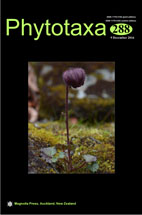Abstract
This paper describes a new, very distinctive, endangered species of Psidium (Myrtaceae, Myrteae) occurring in Bahia in Northeastern Brazil, in the Diamantina Atlantic Forest center of endemism, considered in the Atlantic Forest domain although transitional with the Caatinga domain. It is a small tree up to 5m tall. The species, that we have named Psidium rotundidiscum, is promptly recognized by the combination of petioles 4–7mm long, young leaves that are densely ferrugineous pubescent, spathulate and strongly revolute and mature leaves that are glabrescent, revolute, with an inconspicuous venation. The inflorescences are terminal precocious (auxotelic) racemes with 1–2 pairs of flowers or solitary flowers on new growth. Floral buds are nearly closed, ca. 7–10mm long and densely ferruginous pubescent; specimens with open flowers are unknown. The oblate fruits, with a rounded disk with relatively few staminal scars and rather thick, explanate calyx lobes are also distinctive. The species is known from only three late 20th/early 21st century collections from deciduous forests, semi-deciduous forests, liana forests and xerophytic forests along a North to South extension of ca. 700 km in inland Bahia. Images of collections in bud and in fruit are furnished as well as a geographic distribution map.

